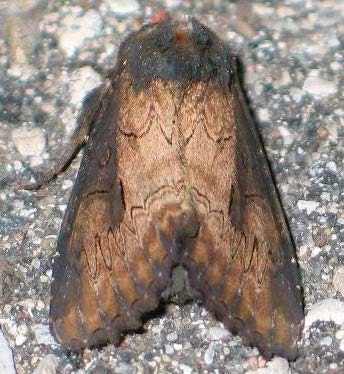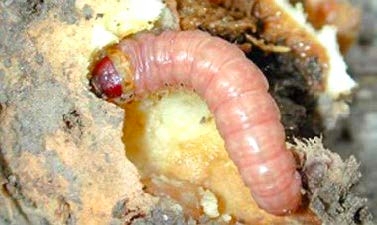Iris Borer
ID
ENTO-140NP (ENTO-418NP)
Description
Adult iris borers are stout, medium sized moths with a wingspan of 4-5 cm (1.5-2 inches). The head and forewings are covered with purplish brown scales and the hind wings are yellowish. The forewings have thin dark zigzag lines, a more conspicuous dark kidney-shaped spot, and variable sooty shading around the margins (Fig. 1). The bottom edge of the forewings is noticeably scalloped. Eggs are highly sculptured and are found primarily in the folds of dried out, brown, dead leaves of iris plants. Initially a creamy color with a greenish tinge, the eggs turn lavender with age. Full grown caterpillars are cylindrical, smooth, and pinkish-white (Fig. 2). They measure up to 4.4 cm (1.7 inches) long. Pupae are dark brown to nearly black and very shiny.
Iris borer, Macronoctua onusta (Grote) (Lepidoptera: Noctuidae)


Life Cycle
Iris borer has a complete life cycle of egg, larval, pupal, and adult stages. Adult females may produce as many as 1,000 eggs. Eggs are laid in the fall on the brown, dried iris leaves and remain there through the winter. Eggs hatch when temperatures rise above 21°C (70°F) and young larvae feed on the surface of fresh, new leaves. Some leaf-mining occurs before the larvae tunnel into the lower parts of the growing plants. They reach the crown and rhizome when about half grown. Larvae tunnel through the rhizomes until they reach maturity and then enter the soil to pupate. Pupation begins in August and adult moths emerge in September and October. There is one generation per year.
Damage
Iris borer attacks all species of iris, including the native blue flag, and sometimes gladiolus and blackberry lily. While iris borer larvae feed on the leaves, the primary damage is done by larger larvae feeding in the rhizomes. Older larvae may hollow out more than one rhizome before pupating. Injured plants surviving the rhizome attack are weakened and susceptible to bacterial soft rot. Because their rhizomes are planted more deeply, Siberian irises may be less susceptible to attack by iris borer.
Distribution
Iris borer is found across the eastern United States wherever their host plants are grown.
Control
Beneficial nematodes such as Steinernema carpocapsae applied to the iris bed can help control iris borer. However, cultural control measures are generally recommended for this pest because they are effective and economical. Small caterpillars on the leaves in the spring can be crushed by hand. Larvae that have begun to mine the leaves can be killed by crushing the leaf along the length of each mine. Plants can tolerate the loss of leaf tissue much better than the later destruction of rhizomes. When dividing irises, examine the newly dug rhizomes closely for iris borer larvae. Kill any larvae found and then cut out areas of the rhizome exhibiting tunneling and soft rot. Cut rhizomes should cure for several days before replanting to limit the spread of rot. Another technique to limit soft rot is to soak the cut rhizomes in a solution of 1 cup household bleach mixed with 1 gallon of lukewarm water for about 10 minutes. Rinse rhizomes well to remove the bleach water solution and then let dry completely before replanting.
Iris borer eggs overwintering on dead foliage are the source of infestation each spring. All dead leaves, dried rhizomes, and damaged plants should be removed from the iris bed and destroyed before new foliage emerges in the spring. It’s best to burn this debris or put it in the trash instead of composting it to avoid having newly emerged larvae spread back to the iris bed from the compost pile.
See the Virginia Pest Management Guide for Home Grounds and Animals (VCE 456-018) for the chemical controls currently recommended for iris borers. Spray plants when new leaves are 12-15 cm (5-6 inches) tall, approximately when the larvae are hatching. Larvae are protected from topical insecticides applied to the plant once they are inside the leaves or rhizomes. For internal infestations of iris borer, a granular systemic insecticide such as imidacloprid and labeled for borers on ornamental plants can be applied several weeks before temperatures reach 21°C (70°F), when the larvae hatch. This allows sufficient time for the plant to take the insecticide up into its tissues before the larvae enter the plant. Apply the material around the base of the plants following the labeled rates and water in deeply, or apply before a good rain.
Revised
Theresa A. Dellinger, January 25, 2021.
Virginia Cooperative Extension materials are available for public use, reprint, or citation without further permission, provided the use includes credit to the author and to Virginia Cooperative Extension, Virginia Tech, and Virginia State University.
Virginia Cooperative Extension is a partnership of Virginia Tech, Virginia State University, the U.S. Department of Agriculture (USDA), and local governments, and is an equal opportunity employer. For the full non-discrimination statement, please visit ext.vt.edu/accessibility.
Publication Date
March 2, 2021



